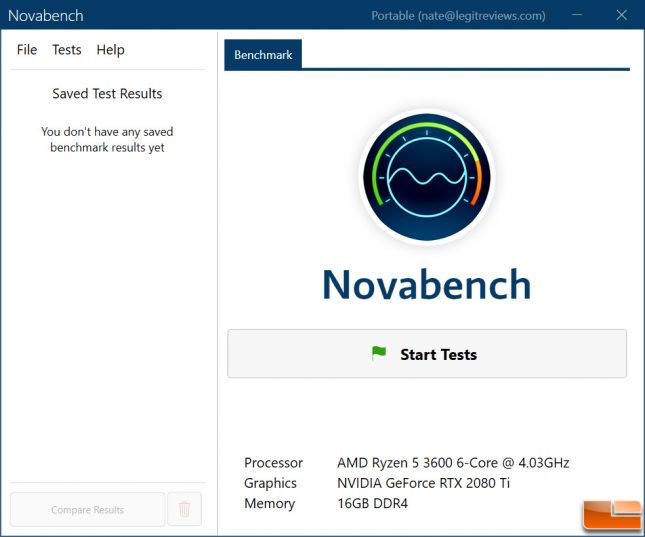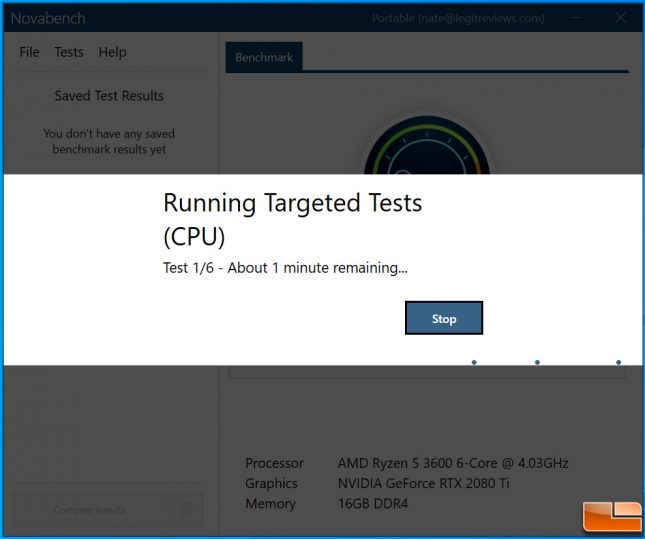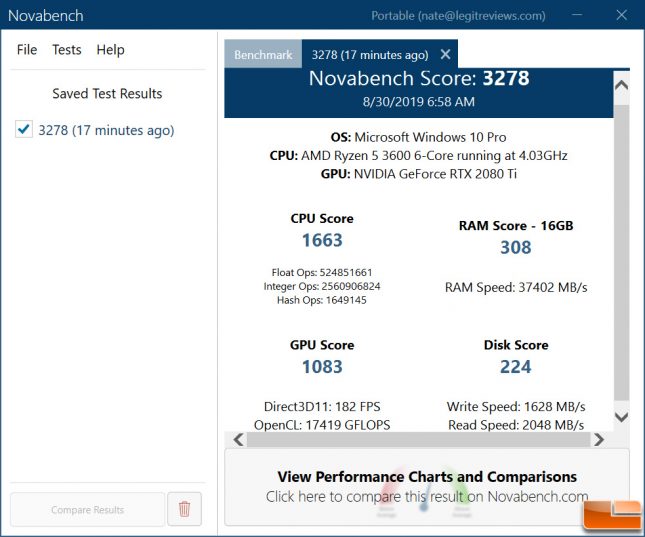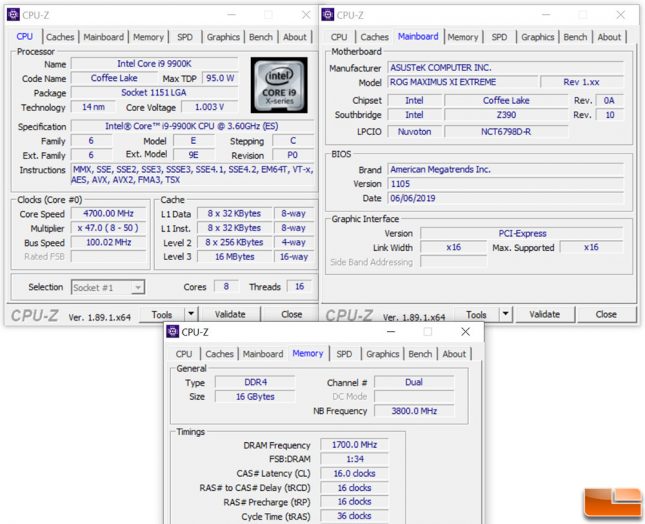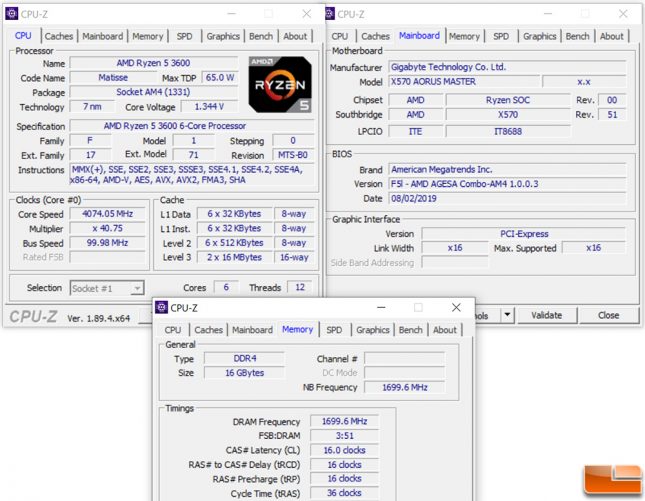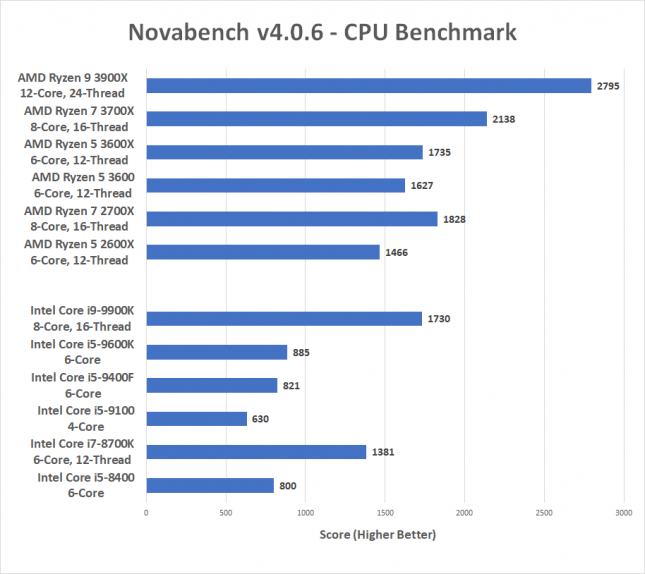12 CPUs Tested Using Novabench Benchmark Software
In our quest to find new CPU benchmarks we were told about Novabench by members of the #SiliconGang on Twitter. Novabench has been around since 2007 and is a free benchmark application that has been used by millions of people. We’ve never ran this benchmark here on Legit Reviews, so we figured that we’d give it a shot.
Novabench tests your computer’s performance in minutes. Your computer’s Novabench Score is easy to compare online – letting you know if your computer isn’t running as well as it could be, or helping you make informed upgrade decisions.
The first thing we noticed with Novabench is that this benchmark utility is it tests the CPU, GPU, RAM and your storage drive. It does this by running a total of six tests and is extremely fast. How fast?
We fired up the stopwatch app on our phone and found that running Novabench was taking about 70 seconds! After the benchmark completes you are given an overall Novabench score and also shown scores for each of the four sub system tests that it completes. This is one of the quickest system benchmarks that we have ever run!
You are also given the scores within each subtest, so you end up with 13 data points from this one benchmark that takes roughly a minute to run. You can then view performance charts and go online to compare your results to others and find out how your system stacks up.
We gave Novabench a try, but we weren’t exactly sure what the Novabench CPU test was doing. After digging around the Novabench website and found out a little more information from the documentation page.
- CPU Targeted Tests – A series of multi-core tests that each target specific instruction pipelines of the CPU. These include general-purpose instructions, the FPU, and other instruction set extensions.
- CPU General Purpose Test – This test allows Novabench to evaluate general CPU performance while controlling for memory performance and other variables.
We then reached out to the author of Novabench asking for more technical details on what exactly his CPU testing was doing. The author was more than happy to help and explained to us over e-mail that Novabench was developed to be a benchmark tool for a broad audience, not necessarily people interested in the technical complexities of benchmark testing. That said, we were quickly given a little more information about what is going on in the benchmark after being informed that we were the only person/site to ever ask for detailed testing information.
- CPU – Novabench runs a few CPU tests, each with single core and multi-core variants. With multi-core tests, the test runs under a few levels of shared memory coordination and localities. Two main tests are implemented in x64 assembly. They’re referred to in Novabench as “integer” and “floating point” tests; the former are using standard arithmetic instructions, the latter are implemented in SSE for broad compatibility. A set of more general tests are measuring a few different encryption and hash functions.
- GPU -Novabench measures draw call performance on a scene rendered with a variety of shader techniques. A more direct measurement of GPU performance (in GFLOPS) is taken with an OpenCL test; a single-precision matrix multiplication kernel.
- RAM – Memory transfer speed is measured with memory store operations implemented in SSE, again for broad compatibility.
So, now that we have a better feel for what Novabench is doing we can get to benchmarking! For testing we will be comparing an Intel Z390 desktop platform to an AMD X570 desktop platform with six processors from each company at several different price points. Windows 10 Pro 64-bit v1903 with all updates as of 8/26/2019 was the operating system used and all the drivers were updated. Both systems used Corsair Hydro Series H115i PRO liquid CPU coolers and the same 1TB NVMe SSD.
The ASUS ROG Maximus XI Extreme motherboard (pricing) was run with BIOS/UEFI version 1105 and the memory was set to operate at 3400 MHz with CL16 timings. ASUS Multi-Core Enhancement (MCE) was disabled.
The Gigabyte X570 AORUS Master motherboard (pricing) for AMD Ryzen processors was running BIOS/UEFI version F5l (AGESA 1.0.0.3 ABB) and also had the memory set to operate at 3400 MHz with CL16 timings.
| CPUs Tested in Novabench v4.0.6 |
|
| Pricing as of 08/27/2019 – Product links in this table are affiliated, and support the website. |
Here are the benchmark results (averaged of 5 runs) of the CPU workload in Novabench v4.0.6:
When looking at the benchmark results we quickly see that AMD Ryzen processors do extremely well on Novabench. In fact, all six of the AMD Ryzen processors that we tested were able to out perform all but one of the six Intel processors tested. The AMD Ryzen 9 3900X had a score of 2,795 points in the CPU test and that was 61.6% higher than the score of 1,730 that we got on the Intel Core i9-9900K processor. AMD clearly knocks it out of the park on the CPU tests used by Novabench.
We asked the author of Novabench if he has ever worked with AMD, Intel, Qualcomm or ARM on any optimizations and if he’d consider his benchmark is fair in this day and age. Legit Reviews was given the following statement.
“I believe Novabench is fair. The implementations are based heavily on established prior art, and all tests use instructions that are mature across vendors. I have never worked with any vendor, such as Intel, AMD, NVIDIA, etc. I believe I have no conflicts of interest in that aspect or otherwise.” – Novabench 08/29/2019
So, there is another benchmark utility that we have never used before with some interesting results. We’d also like to thank Novabench for discussing their benchmark application with Legit Reviews. They were happy to go on record about their benchmark and that is refreshing.
If you want to try Novbabench out you can download it for free here. They also offer Novabench Pro for $19 with additional features like battery wear and temperature tracking, scheduled tasking, CLI and more.

